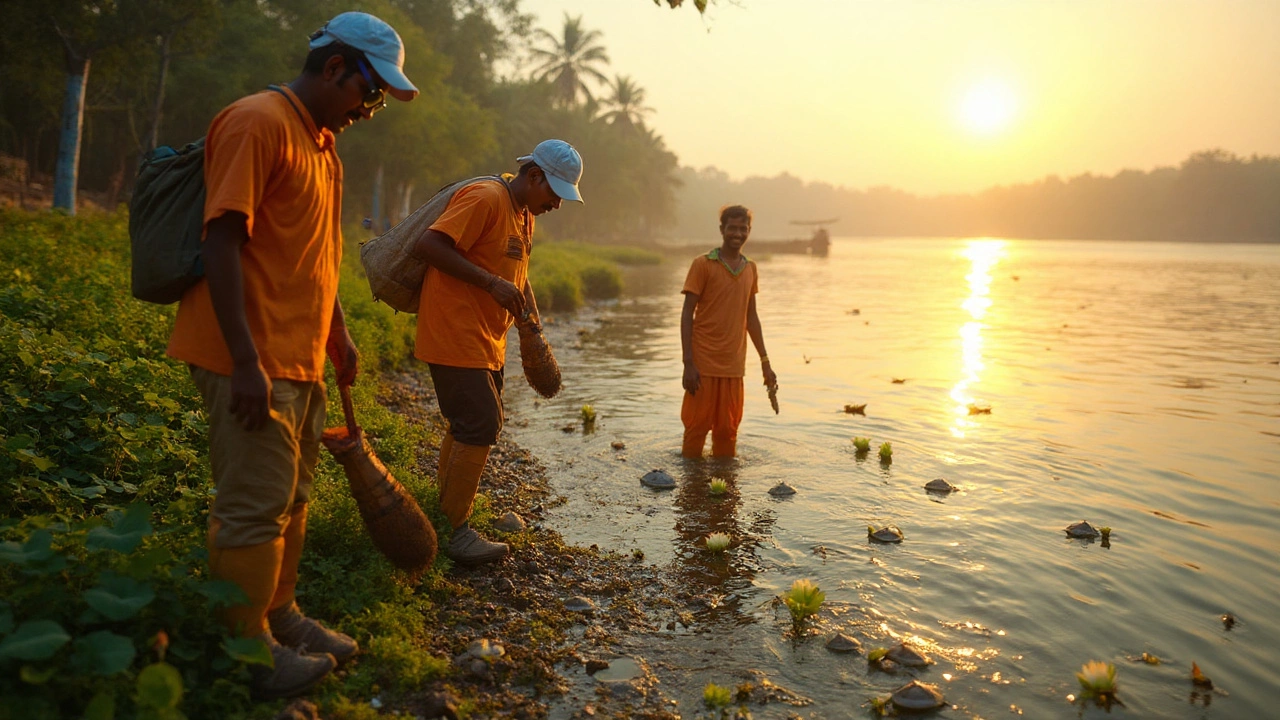Environment Group Quiz
1. What are the core functions of an environment group?
2. Which type of environment group typically has the largest size of members?
3. What is one way to get involved with an environment group?
Environment group is a collective organization that focuses on protecting, restoring, or advocating for the natural environment. These groups can range from small neighbourhood clean‑up crews to internationally recognised NGOs, but they all share a common mission: promote a healthier planet.
Core Functions of an Environment Group
At its heart, an environment group acts in three major ways:
- Conservation - preserving habitats, species, and natural resources.
- Advocacy - influencing policy, public opinion, and corporate behavior.
- Education - raising awareness through workshops, campaigns, and school programs.
These functions often overlap. For example, a river‑cleaning club not only removes debris (conservation) but also educates residents about water quality (education) and may lobby the council for better waste management (advocacy).
Key Related Entities
Understanding an environment group becomes easier when you see how it connects to other concepts.
Non‑profit organization is a legal entity that operates without profit distribution to members, reinvesting surplus into its mission. Most environment groups register as non‑profits to access tax‑exempt status and grant funding.
Grassroots movement is a bottom‑up initiative driven by local volunteers rather than top‑down leadership. Many small environment groups start as grassroots movements before formalising.
Sustainability is a development approach that meets present needs without compromising future generations. Environment groups embed sustainability into their projects, whether planting trees or promoting circular economies.
Advocacy is a strategic effort to shape public policy, corporate practices, or societal attitudes. Successful environmental advocacy often involves petitions, public hearings, and media campaigns.
Policy influence is a the process of affecting legislation, regulations, or governmental programs. Environment groups may submit research, draft proposals, or sit on advisory panels.
Community is a group of people sharing geography, interests, or identity, often collaborating on local projects. Strong community ties boost an environment group’s volunteer base and relevance.
Fundraising is a activity aimed at securing monetary or in‑kind resources to support operations. Typical channels include grants, crowd‑funding, and corporate sponsorships.
Types of Environment Groups
While every group shares a green goal, they differ in scale, legal form, and funding. The table below highlights the most common categories.
| Type | Legal Status | Typical Funding Sources | Usual Size (members) | Main Focus |
|---|---|---|---|---|
| Grassroots Collective | Informal association | Donations, fundraising events | 5‑50 | Local clean‑ups, awareness |
| Registered NGO | Charitable trust / incorporated society | Grants, corporate sponsorship, membership fees | 100‑10,000+ | Policy advocacy, large‑scale projects |
| Community Alliance | Cooperative or partnership | Local council funding, member contributions | 20‑500 | Neighborhood greening, education |
| Student Environmental Club | School‑based club (informal) | School budget, small grants | 10‑200 | Campus sustainability initiatives |
Organisational Structure and Governance
Most environment groups adopt a clear governance model to stay accountable:
- Board of Trustees or Directors - sets strategic direction, ensures legal compliance.
- Executive Committee - handles day‑to‑day operations, project management.
- Volunteer Teams - execute field work, outreach, and events.
- Advisory Panel - provides expertise (ecologists, lawyers, business leaders).
Transparency is key. Annual reports, publicly posted minutes, and open financial statements build trust with donors and the community.

Impact Areas Where Environment Groups Make a Difference
Whether you’re looking at climate change, biodiversity, or waste reduction, an environment group can be a catalyst.
- Climate Action - organizing tree‑planting drives, promoting renewable energy adoption, lobbying for carbon‑pricing policies.
- Habitat Restoration - re‑vegetating wetlands, removing invasive species, protecting nesting sites.
- Plastic Pollution Prevention - beach clean‑ups, corporate negotiations for reduced single‑use plastics, educational campaigns in schools.
- Water Quality Improvement - monitoring river health, advocating for stricter runoff regulations, community rain‑garden installations.
Data from the New Zealand Ministry for the Environment shows that community‑led clean‑up projects removed over 1.2million kilograms of litter from coastlines between 2018‑2023, illustrating tangible outcomes.
How to Get Involved with an Environment Group
Ready to roll up your sleeves? Here are five practical pathways:
- Volunteer on a Project - sign up for a local tree‑planting day or beach sweep.
- Become a Member - pay a modest annual fee; you’ll receive newsletters and voting rights.
- Donate - even a $10 monthly contribution can fund educational kits for schools.
- Attend a Meeting - hear decisions in real time and voice ideas.
- Start Your Own Initiative - use the guidelines below to launch a micro‑group in your neighbourhood.
If you choose the last option, follow this quick‑start checklist:
- Define a clear mission (e.g., “Reduce single‑use plastic in Grey Lynn”).
- Register as an informal association (no legal paperwork needed for very small groups).
- Set up a simple bank account for donations.
- Recruit 5‑10 enthusiastic volunteers.
- Plan a launch event to attract media attention.
Remember, the impact of a small, well‑organized group often outweighs that of a larger, bureaucratic one because decisions are made quickly and locally.
Connecting the Dots: Related Concepts and Next Steps
Exploring an environment group opens doors to a broader knowledge network:
- Environmental Justice - ensures that low‑income or indigenous communities aren’t disproportionately harmed by pollution.
- Circular Economy - designs waste‑free systems; many groups run repair cafés or clothing swaps.
- Community Resilience - builds capacity to withstand climate‑related shocks (floods, heatwaves).
- Science Communication - translates research findings into plain language for public action.
After you’ve grasped the basics of an environment group, you might want to dive deeper into topics like “How to lobby local councils effectively” or “Measuring carbon footprints for community projects.” Those are natural next chapters in the sustainability learning path.
Real‑World Example: Auckland’s ‘Green Shores’ Initiative
In 2022, a coalition of three local environment groups - the Auckland Conservation Trust, the Beachcare Collective, and the Urban Biodiversity Network - launched the ‘Green Shores’ program. Within 18 months they:
- Planted 12,000 native trees along the western shoreline.
- Organised 45 community clean‑ups, removing 850tons of debris.
- Secured a $500,000 grant from the city council for a coastal wetland restoration.
The initiative showcases how diverse groups can pool resources, share expertise, and achieve outcomes far beyond what any single entity could accomplish alone.
Why the Term environment group Matters
Using precise language helps donors, volunteers, and policymakers understand exactly who they’re dealing with. An “environment group” signals a focused, mission‑driven collective, distinguishing it from generic “green” companies that may prioritize profit over planet.

Frequently Asked Questions
What distinguishes an environment group from a for‑profit green business?
The key difference is purpose. An environment group is a non‑profit (or informal) entity that reinvests any surplus into environmental projects. A green business, even if eco‑friendly, aims to generate profit for owners or shareholders.
Do I need legal training to start an environment group?
No. Many successful groups begin as informal volunteer networks. As they grow, registering as a charitable trust or incorporated society can provide tax benefits and grant eligibility, but this step can be taken later.
How can I tell if an environment group is credible?
Look for transparent finances (annual reports), clear governance (board listings), and measurable outcomes (e.g., number of trees planted, liters of water saved). Membership in recognized networks like the New Zealand Conservation Council also adds credibility.
What are typical funding sources for small environment groups?
Small groups often rely on community fundraising events (car washes, bake sales), local business sponsorships, crowd‑funding campaigns, and occasional grants from municipal councils or environmental foundations.
Can I volunteer if I have no prior environmental experience?
Absolutely. Most groups welcome newcomers and provide on‑the‑spot training. The most important assets are enthusiasm and a willingness to learn.
How do environment groups measure their impact?
Impact is tracked through quantitative metrics (e.g., kilograms of litter removed, hectares of habitat restored) and qualitative outcomes (community awareness surveys, policy changes). Many groups publish annual impact reports to showcase results.
Is it possible to join an environment group remotely?
Yes. Digital activism, virtual webinars, and online fundraising are common. Remote volunteers can help with social‑media management, research, grant writing, and campaign design.
Where can I find a list of local environment groups in Auckland?
Check the Auckland Council’s community directory, the New Zealand Conservation Trust’s partner list, or platforms like Volunteer NZ. Many groups also maintain active Facebook or Instagram pages for recruitment.






